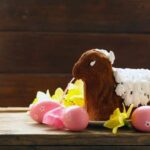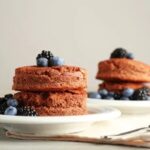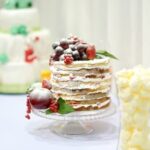Are you looking to perfect your cake decorating skills with buttercream frosting? Whether you’re a beginner or an experienced baker, mastering the art of buttercream frosting cake decoration can take your baked creations to the next level. In this article, we will guide you through the essential tools and techniques for creating beautiful designs and patterns with buttercream frosting. From preparing and coloring the frosting to troubleshooting common issues, we’ve got you covered.
Buttercream frosting is a versatile and delicious option for decorating cakes, cupcakes, and other sweet treats. It’s a classic choice that allows for endless possibilities when it comes to design and flavor. With the right tools and ingredients, along with some helpful tips, you can elevate your cake decorating game with buttercream frosting.
In the following sections, we will delve into the essential tools and ingredients needed for cake decorating with buttercream frosting, as well as how to prepare and color the frosting to achieve the perfect look for your baked creations. We’ll also explore different techniques for applying buttercream frosting to a cake, creating eye-catching designs and patterns that are sure to impress. So let’s get started on our journey to mastering the art of buttercream frosting cake decoration.
Essential Tools and Ingredients for Cake Decorating With Buttercream Frosting
When it comes to cake decorating with buttercream frosting, having the right tools and ingredients is essential for creating beautiful and delicious desserts. One of the most important tools for cake decorating is a good quality offset spatula, which allows for smooth and precise application of the frosting. Piping bags and various tips are also essential for creating different textures and designs on the cake.
In addition to tools, it’s important to have high-quality ingredients when working with buttercream frosting. This includes using unsalted butter, as well as pure vanilla extract for flavoring. Confectioners’ sugar is used to sweeten and thicken the frosting, while heavy cream or milk can be added to achieve the desired consistency.
Another essential ingredient for cake decorating with buttercream frosting is gel food coloring. Unlike liquid food coloring, gel colors won’t affect the consistency of the frosting and allow you to achieve vibrant shades without adding too much liquid. With these essential tools and ingredients in hand, you’ll be ready to start decorating your cakes with buttercream frosting like a pro.
When preparing your buttercream frosting, it’s important to start with room temperature butter to ensure a smooth texture. If the butter is too cold or too warm, it can result in lumpy or greasy frosting. Gradually add in the confectioners’ sugar and mix thoroughly until you reach the desired consistency. Adding a small amount of heavy cream or milk can help make the frosting more spreadable or pipeable depending on your needs.
Preparing and Coloring the Buttercream Frosting
Once you have gathered all the essential tools and ingredients for cake decorating with buttercream frosting, the next step is to prepare and color the frosting. This process is crucial as it sets the foundation for creating beautiful and tasty designs on your cake.
To start, you will need to prepare a batch of buttercream frosting using powdered sugar, unsalted butter, vanilla extract, and a pinch of salt. It’s important to use room temperature butter to achieve a smooth and creamy texture. Beat the ingredients together until the mixture is light and fluffy.
After preparing the base frosting, it’s time to add colors. Gel food coloring is recommended for tinting buttercream frosting as it offers vibrant hues without altering the consistency of the frosting. Start with small amounts of food coloring and mix well before adding more, as a little goes a long way. You can create a variety of shades by mixing different colors together, allowing you to customize the frosting according to your desired cake design.
Once your buttercream frosting is prepared and colored, you are ready to move on to the next steps in cake decorating. Whether you’re going for a simple single color or an intricate multi-colored design, mastering the art of preparing and coloring buttercream frosting is essential for creating visually stunning cakes that taste as good as they look.
Choosing the Right Cake for Buttercream Frosting Decorating
When it comes to decorating a cake with buttercream frosting, choosing the right type of cake is essential for a successful outcome. The texture and crumb of the cake can greatly impact how well the frosting adheres and holds its shape. For buttercream frosting, it’s best to use a cake that is not too crumbly or delicate, as these types of cakes may cause the frosting to crumble and not hold its design.
One popular choice for buttercream frosting decoration is a classic vanilla sponge cake. This type of cake has a fine crumb and a soft but sturdy texture, making it an ideal canvas for intricate designs and patterns. Other options include chocolate cake, red velvet cake, or even a moist carrot cake – all of which provide a good base for buttercream frosting decorating.
Another important consideration when choosing the right cake for buttercream frosting decoration is the flavor profile. It’s crucial to select a cake flavor that complements the taste of the buttercream frosting. For example, a light and fluffy angel food cake pairs well with fruity or citrus-flavored frostings, while a rich chocolate cake is perfect for pairing with indulgent and decadent buttercream flavors.
Ultimately, selecting the right type of cake for buttercream frosting decoration involves considering both the texture and flavor compatibility with the chosen frosting. By taking these factors into account, you can ensure that your finished product is not only visually appealing but also delicious in every bite.
| Choosing the Right Cake | Considerations |
|---|---|
| Texture | Not too crumbly or delicate |
| Flavor Profile | Complements the taste of buttercream |
Different Techniques for Applying Buttercream Frosting to a Cake
When it comes to cake decorating with buttercream frosting, there are several techniques that can help you achieve a professional-looking result. One of the most common methods is the “flat top” technique, where you spread the buttercream evenly across the top and sides of the cake using an offset spatula. This creates a smooth and polished finish that is perfect for more formal occasions.
Another popular technique is the “textured” or “rustic” look, which involves using the spatula to create swirls and peaks in the buttercream frosting. This gives the cake a more casual and homemade appearance, which can be great for a variety of events from birthdays to weddings. Additionally, piping bags and various tips can be used to create intricate designs and patterns on the cake’s surface, adding an extra level of detail that can really make your creation stand out.
In addition to these techniques, it’s important to consider factors such as temperature and consistency when applying buttercream frosting. For example, if your frosting is too warm, it may not hold its shape well when piped onto the cake.
On the other hand, if it’s too cold, it can be difficult to work with and may not spread smoothly. Finding the right balance and knowing how to work with different consistencies will ultimately help you achieve the best results in your cake decorating endeavors.
| Technique | Description |
|---|---|
| Flat Top | Evenly spreading buttercream across the top and sides of the cake for a smooth finish. |
| Textured/Rustic | Creating swirls and peaks in the buttercream for a casual and homemade appearance. |
| Piping Designs | Using piping bags and tips to create intricate patterns on the cake’s surface. |
Creating Designs and Patterns With Buttercream Frosting
When it comes to cake decorating, buttercream frosting offers a versatile medium for creating beautiful designs and patterns. Whether you’re a beginner or an experienced baker, there are countless ways to get creative with buttercream frosting. Here are some techniques for creating stunning designs on your cakes:
1. Piping: One of the most common ways to create designs with buttercream frosting is through piping. Using a pastry bag and various tips, such as star tips, round tips, or petal tips, you can pipe intricate borders, flowers, rosettes, and other decorative elements onto your cake.
2. Spatula Painting: Another technique for creating designs with buttercream frosting is spatula painting. This involves using an offset spatula to spread different colors of buttercream onto the cake in a painterly fashion, creating beautiful ombre effects or abstract designs.
3. Texturing: You can also create interesting textures by using tools such as combs or textured mats to imprint patterns onto the surface of the buttercream frosting. This adds depth and visual interest to your cake design.
These are just a few examples of how you can use buttercream frosting to create stunning designs on your cakes. The possibilities are endless, and experimenting with different techniques will help you discover your own unique style in cake decorating.
Tips for Perfecting Your Buttercream Frosting Cake Decorating
Now that you have mastered the basics of buttercream frosting cake decorating, it’s time to focus on perfecting your skills. Whether you are a beginner or have some experience with cake decorating, there are always tips and tricks to improve your technique and achieve professional-looking results.
First and foremost, it is important to ensure that your buttercream frosting is at the right consistency for decorating. If the frosting is too stiff, it will be difficult to spread and create smooth surfaces. On the other hand, if the frosting is too runny, it will not hold its shape when piped onto the cake. To achieve the perfect consistency, consider adjusting the amount of liquid or powdered sugar in your recipe.
Another tip for perfecting your buttercream frosting cake decorating is to invest in good quality piping bags and tips. The right tools can make a significant difference in your decorating results. Make sure to have a variety of piping tips on hand to create different designs and textures on your cakes.
In addition, practice makes perfect when it comes to cake decorating with buttercream frosting. Take the time to experiment with different techniques and designs. Don’t be afraid to make mistakes – they are all part of the learning process. With patience and perseverance, you will improve your skills and create beautiful, professional-looking cakes every time.
Troubleshooting Common Issues With Buttercream Frosting Decoration
Issues With Consistency
One common issue when decorating a cake with buttercream frosting is the consistency of the frosting. If the frosting is too stiff, it can be difficult to spread and may not adhere well to the cake. On the other hand, if the frosting is too soft, it can be challenging to create intricate designs and patterns. To troubleshoot this issue, consider adjusting the amount of liquid or powdered sugar in your recipe to achieve the desired consistency.
Air Bubbles
Another problem that many decorators encounter when working with buttercream frosting is air bubbles. These pesky bubbles can create an uneven texture on the surface of the cake, ruining the smooth finish you were going for. To prevent air bubbles from forming in your frosting, try gently tapping the filled piping bag on a flat surface before starting to decorate. This will help release any trapped air and ensure a smoother application.
Buttercream Melting
In warmer temperatures or if placed in direct sunlight, buttercream frosting has a tendency to melt, causing designs to lose their shape and definition. To avoid this issue, store your decorated cake in a cool environment until ready to serve. Additionally, consider using less butter and more powdered sugar in your recipe for a more stable frosting that can withstand warmer conditions without losing its form.
By troubleshooting these common issues with buttercream frosting decoration, you can ensure that your cake decorating endeavors are successful and stress-free. With a few adjustments and some practice, you’ll be able to create beautifully decorated cakes that are sure to impress.
Conclusion
In conclusion, buttercream frosting is a versatile and beautiful medium for cake decorating. With the right tools and ingredients, you can create stunning designs and patterns on your cakes that will impress your friends and family. From simple swirls to intricate flowers, the possibilities are endless when it comes to decorating with buttercream frosting.
One of the most important aspects of mastering buttercream frosting cake decorating is understanding how to properly prepare and color the frosting. By using the right techniques and incorporating vibrant colors, you can elevate the visual appeal of your cakes to new heights. Additionally, choosing the right type of cake for buttercream frosting decoration can make a significant difference in the final product.
As you continue to practice and experiment with different techniques for applying buttercream frosting to a cake, you will develop your own unique style and artistic flair. Whether you prefer smooth finishes or textured designs, there are countless ways to showcase your creativity through buttercream frosting decoration. Remember to keep refining your skills and seeking inspiration from other decorators to continually improve how to buttercream frosting cake decorating craftsmanship.
Frequently Asked Questions
How to Decorate a Cake With Buttercream Frosting?
Decorating a cake with buttercream frosting involves using a piping bag to create swirls, rosettes, or other designs on the cake’s surface. You can also use a spatula to create a smooth or textured finish, depending on your preference.
What Is the Trick to Buttercream Frosting?
The trick to making buttercream frosting is to ensure that the butter is at the right temperature before starting. It should be softened but not melted, and mixing it well with the other ingredients is essential for achieving a smooth and creamy texture.
How Do You Get Buttercream to Stick to a Cake?
To get buttercream to stick to a cake, it’s important to start with a properly cooled cake and apply a thin layer of frosting as a base or crumb coat. This helps the additional layers of buttercream adhere better to the cake surface.
Additionally, gently pressing the frosting onto the cake as you spread it will help it stick more effectively.

Welcome to my blog about home and family. This blog is a place where I will share my thoughts, ideas, and experiences related to these important topics. I am a stay-at-home mom with two young children. I hope you enjoy reading it! and may find some helpful tips and ideas that will make your home and family life even better!





